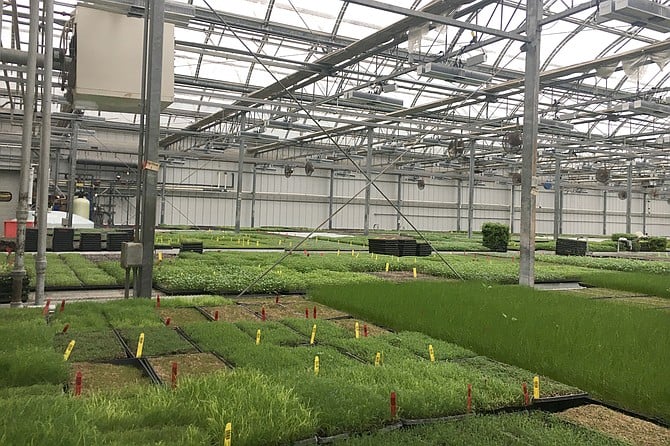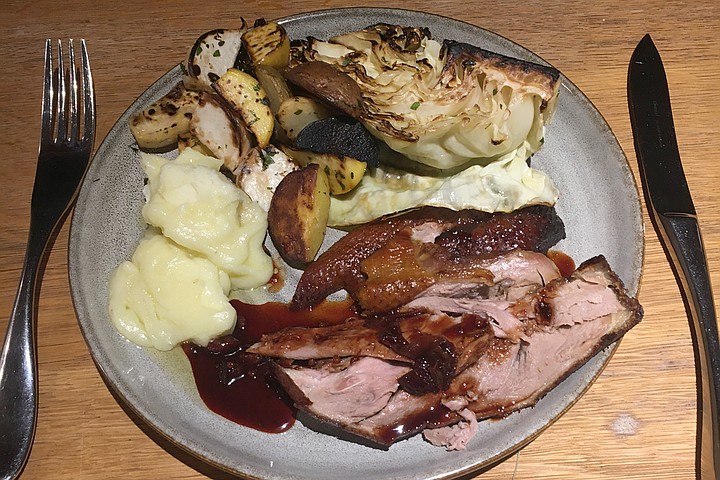 Facebook
Facebook
 X
X
 Instagram
Instagram
 TikTok
TikTok
 Youtube
Youtube

Ohioan Farmer Lee Jones, considered by many to be “America’s Farmer,” moved his family’s farm to create an original concept: specialty grower for the finest chefs in the US and abroad. Recently, Mr. Jones made a cameo appearance in the film festival darling, Love, Charlie about Michelin-starred chef Charlie Trotter. Trotter was one of the first chefs to make vegetarian tasting menus appetizing. Of course, Farmer Lee Jones supplied the building blocks. When the pandemic shut down restaurants, Mr. Jones created vegetable boxes for consumers, which are still available.
Gourmet chefs travel from around the world to rural Milan, Ohio (about an hour from Cleveland) to see the beginnings of their art. His liaison chef, Jamie Simpson, cooks for VIPs and tests recipes with unusual, experimental produce.

Farmer Lee Jones created a wood and stone A-frame facility with a 1,500 sq. foot double-high ceiling professional kitchen, dining room, a root and wine cellar, overnight accommodations and a rare cookbook library. Since the pandemic, they’ve opened for occasional Air B&B bookings and corporate and group retreats. Colorful wild peacocks keep close to the building, knowing that fresh snacks are likely forthcoming. This is the epicenter of The Culinary Vegetable Institute.
Mere civilians can experience what the celebrity chefs do: homestyle luxury. The property abuts the Huron River, and tree groves. I learned that – surprisingly — what chefs like to do when not working is ... more cooking. There are a few different rooms, but the spacious suite has a kitchen, including two refrigerators. A rack holds a mini-bar, with a selection of wines and champagnes. But, since chefs like to mix high-brow and low-brow, you’ll find local microbrews and some PBRs chilling.
Non-professional chefs like me are given Chef Simpson assembled and pre-cooked meals to fix for themselves: you heat things up and finish them, garnish. Just like the pros, you’re working with Chef’s Garden vegetables, herbs and microgreens. I was there just after Thanksgiving, so I found myself making roast duck with cranberry sauce and sides. While waiting for ingredients to lose their refrigerator chill – “temper,” in chefs’ parlance – I grabbed a bottle of wine and checked out the cookbook library next to the suite. A little alcove has been given a custom stained-glass window, so it resembles a chapel crossed with one of the great European university libraries. There are vintage, leather-bound cooking magazines, cookbooks sent by chef friends, several tomes on vegetables and vegetarian cuisine.
When not cooking or tidying up, chefs and non-chefs can turn up the gas fireplace, play the guitar on a stand, splash around in the gigantic hot tub.
Nearby is a state-of-the-art lab facility where scientists from around the world test plants for health, nutritional content and other measures, such as sweetness. When they say a vegetable beats USDA vitamin content requirements, you can take that to the bank. The greenhouses are staffed with growers. They mind the precious microgreens, which each chef apparently likes to be sent at stages: for individual flavor profiles and probably, as a competitive point of difference. I took the opportunity to ask about my sad little window box garden, which did a measly job of contributing to my table during the lockdowns. From my description of things, it was determined that my soil is probably too acidic. The packing rooms include a giant composting bin that holds better-looking produce than what’s at your grocery store, I promise.
Chefs are renowned for burning the candle at both ends. Accordingly, I was up and at ‘em early to see Farmer Lee Jones doing his farm chores. Farm animals all have a job, whether they’re cats keeping the barn clear, chickens laying eggs or big, bossy Belgian draft horses who pull Christmastime sleighs. Then, it was onto the Farm Market, open weekends for people to get seasonal produce, food products, and cutting boards. The cutting boards are special and they have to be: there’s a lot riding on them. Last year, the family’s historic barn burned to the ground, and vintage farm vehicles and sleighs were lost forever. An artistic neighbor has taken it upon himself to use trees on the property to carve boards as a fundraiser. People can use them to present charcuterie or the new entertaining trend – “butter boards.”


Ohioan Farmer Lee Jones, considered by many to be “America’s Farmer,” moved his family’s farm to create an original concept: specialty grower for the finest chefs in the US and abroad. Recently, Mr. Jones made a cameo appearance in the film festival darling, Love, Charlie about Michelin-starred chef Charlie Trotter. Trotter was one of the first chefs to make vegetarian tasting menus appetizing. Of course, Farmer Lee Jones supplied the building blocks. When the pandemic shut down restaurants, Mr. Jones created vegetable boxes for consumers, which are still available.
Gourmet chefs travel from around the world to rural Milan, Ohio (about an hour from Cleveland) to see the beginnings of their art. His liaison chef, Jamie Simpson, cooks for VIPs and tests recipes with unusual, experimental produce.

Farmer Lee Jones created a wood and stone A-frame facility with a 1,500 sq. foot double-high ceiling professional kitchen, dining room, a root and wine cellar, overnight accommodations and a rare cookbook library. Since the pandemic, they’ve opened for occasional Air B&B bookings and corporate and group retreats. Colorful wild peacocks keep close to the building, knowing that fresh snacks are likely forthcoming. This is the epicenter of The Culinary Vegetable Institute.
Mere civilians can experience what the celebrity chefs do: homestyle luxury. The property abuts the Huron River, and tree groves. I learned that – surprisingly — what chefs like to do when not working is ... more cooking. There are a few different rooms, but the spacious suite has a kitchen, including two refrigerators. A rack holds a mini-bar, with a selection of wines and champagnes. But, since chefs like to mix high-brow and low-brow, you’ll find local microbrews and some PBRs chilling.
Non-professional chefs like me are given Chef Simpson assembled and pre-cooked meals to fix for themselves: you heat things up and finish them, garnish. Just like the pros, you’re working with Chef’s Garden vegetables, herbs and microgreens. I was there just after Thanksgiving, so I found myself making roast duck with cranberry sauce and sides. While waiting for ingredients to lose their refrigerator chill – “temper,” in chefs’ parlance – I grabbed a bottle of wine and checked out the cookbook library next to the suite. A little alcove has been given a custom stained-glass window, so it resembles a chapel crossed with one of the great European university libraries. There are vintage, leather-bound cooking magazines, cookbooks sent by chef friends, several tomes on vegetables and vegetarian cuisine.
When not cooking or tidying up, chefs and non-chefs can turn up the gas fireplace, play the guitar on a stand, splash around in the gigantic hot tub.
Nearby is a state-of-the-art lab facility where scientists from around the world test plants for health, nutritional content and other measures, such as sweetness. When they say a vegetable beats USDA vitamin content requirements, you can take that to the bank. The greenhouses are staffed with growers. They mind the precious microgreens, which each chef apparently likes to be sent at stages: for individual flavor profiles and probably, as a competitive point of difference. I took the opportunity to ask about my sad little window box garden, which did a measly job of contributing to my table during the lockdowns. From my description of things, it was determined that my soil is probably too acidic. The packing rooms include a giant composting bin that holds better-looking produce than what’s at your grocery store, I promise.
Chefs are renowned for burning the candle at both ends. Accordingly, I was up and at ‘em early to see Farmer Lee Jones doing his farm chores. Farm animals all have a job, whether they’re cats keeping the barn clear, chickens laying eggs or big, bossy Belgian draft horses who pull Christmastime sleighs. Then, it was onto the Farm Market, open weekends for people to get seasonal produce, food products, and cutting boards. The cutting boards are special and they have to be: there’s a lot riding on them. Last year, the family’s historic barn burned to the ground, and vintage farm vehicles and sleighs were lost forever. An artistic neighbor has taken it upon himself to use trees on the property to carve boards as a fundraiser. People can use them to present charcuterie or the new entertaining trend – “butter boards.”
Comments